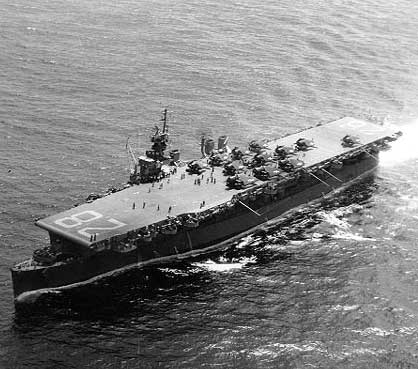|
The USS Cabot was the 7th of 9 Independence Class Light Aircraft Carriers which were started from May 1, 1941 through October 26, 1942 at the New York Ship Building Yard in Camden New Jersey.
The keel of the light aircraft carrier USS Cabot (CVL-28) was laid down as the light cruiser Wilmington (CL-79) on March 16, 1942. On June 2, 1942 the under construction cruiser Wilmington was ordered to be converted into a light aircraft carrier by the addition of a hanger deck and flight deck above that.
 Specifications: Specifications:
Design Displacement: 14,200 tons
Full load Displacement: 15,100 tons
Overall Length: 622' 6"
Waterline Length: 600'
Beam (Extreme): 109' 2"
Beam Waterline: 71' 6"
Flight Deck: 572' x 73'
Catapult: 1 H 2-1 Hydraulic
Propulsion: 4 Babcock & Wilson 565 psi boilers,
4 shaft geared turbines,100,000 shp
Machinery: 4 - 600kw ships service generators
2 - 250kw diesel generators
Fuel Capacity: 2,632.2 tons
Aviation Gas: 122,243 gallons
Aviation Ordinance: 331.4 tons
Top Speed: 31.6 knots
Crew: 1,461
Armor: 3-5 inch belt
Armament: 2 quad, 8 dual 40 mm AA,
16 single 20 mm AA
Aircraft: 45 (maximum) 32 (nominal)
USS Cabot was launched on April 4, 1943 and commissioned on July 24, 1943. Her 1 month shake down cruse to Trinidad was undertaken September after which she left for Pear Harbor and joined Task Force 58 for action in the pacific.
USS Cabot carried Air Group 31 from the time of her shake down cruse until they were rotated out of active duty in October of 1944. Air Group 31 was replaced by Air Group 29 who served aboard her until July 11, 1945 when they were relieved by Air Group 32 who served for the last 6 weeks until the end of hostilities.
The famous Scripps-Howard war corespondent Ernie Pyle came on board the USS Cabot for a time. He wrote his famous "Iron Woman" story while he was aboard USS Cabot
USS Cabot was stuck by a Kamikaze on November 25, 1944. This caused the death of 62 of her crew but the ship was saved. She was repaired at the advance fleet anchorage of Ulithi and returned to duty on December 11, 1944. She was send to be overhauled in San Francisco in March 1945 and returned to the Pacific in late June 1945. USS Cabot stayed on station during September and October 1945 in the Yellow Sea supporting the occupation. Cabot was used to transport returning men from Guam to San Diego, arriving on November 9, 1945. USS Cabot then returned via the Panama Canal to the Philadelphia Naval Yard where she was docked along with 2 CVL aircraft carriers and other vessels.
USS Cabot was decommissioned to reserve status on February 11, 1946 at the Philadelphia Naval Yard.
Re-commissioned on October 27, 1948 she was modernized which included combining her existing 4 funnels into 2. Cabot served as a Naval Aviation Reserve Training carrier operating out of NAS Pensacola, then NAS Quonset Point, on training cruises to the Caribbean. She had one tour of duty in European and Mediterranean waters from January to March 1952 and served as an ASW (Anti Submarine Warfare) carrier
USS Cabot was decommissioned to reserve status once again on January 21, 1955
While still in reserve status USS Cabot was re-designated as an aircraft transport carrier (AVT-3) on May 15, 1959.
USS Cabot was reactivated, overhauled and modernized at the Philadelphia Naval Yard from 1965 - 1967 in preparation for loan to Spain.
USS Cabot was re-commissioned as the Spanish Naval Ship SNS Dedalo (AO-1) on August 30, 1967.
USS Cabot was stricken from the U.S. Naval records on August 1, 1972 and sold to Spain on December 5, 1972.
USS Cabot served the Spanish Navy as SNS Dedalo from 1967 through 1989 first as a helicopter carrier and later as a Harrier jump jet carrier.
The Government of Spain decommissioned and gave USS Cabot / SNS Dedalo to the Cabot/Dedalo foundation on August 5, 1989 in New Orleans Louisiana. At that time the USS Cabot was in just about the same condition as she was when she served the US Navy in 1944-1945, retaining all of her war time machinery and fittings, including the original WW II AA guns and interior.
The Cabot/Dedalo foundation tried, unsuccessfully, to find a permanent home for the ship but while awaiting a permanent location the USS Cabot sat at an unused wharf in New Orleans from 1989 until she was ordered removed by the Coast Guard as a hazard to navigation on September 10, 1997.
On October 13, 1997 the USS Cabot was dead towed from her berth in the Mississippi River to Port Isabel Texas. She stayed moored in Port Isabel Texas from October 1997 until August 8, 1998 when she was once again dead towed to Brownsville Texas for breaking.
A US Court ordered the sale of the USS Cabot to clear the debts that had amassed over the years and on September 10, 1999 USS Cabot was sold to the Sable Marine salvage company for the high bid of $185,000.00
Breaking of the USS Cabot started in October 2000 and the last of the Cabot was cut up in March 2003
Final Admiralty Court Decision - July 1, 2002 - EX-USS Cabot/Dedalo
Links to other sites with information about the Light Carrier USS Cabot CVL-28
USS Cabot Association: http://www.geocities.com/usscabot/cabmen.html
USS Cabot information George DeLange: http://www.delange.org/Cabot/Cabot.htm
USS Cabot Museum: http://www.usscabot.com/
Haze Gray and Underway History and Photos of USS Cabot: http://www.hazegray.org/navhist/carriers/cabot/
USS Cabot - US Navy web site http://www.chinfo.navy.mil/navpalib/ships/carriers/histories/cv28-cabot/cv28-cabot.html
|

 Specifications:
Specifications: